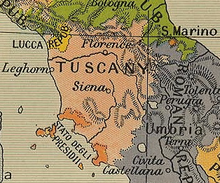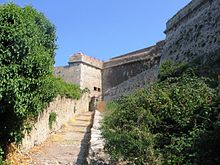Stato dei Presidi
The Tuscan port and fortress cities Talamone , Orbetello , Porto Ercole , Porto Santo Stefano and Ansedonia , the archipelago in front of them and the Porto Longone castle on Elba with the associated fort became Stato dei Presidi ("State of fortresses") Designated surrounding area. These strategically important places were conveniently located and formed a garrison state, which was under the sovereignty of the Kingdom of Naples , which also belonged to Spain . The Stato dei Presidi primarily served to defend against the Ottomans and the barbarians in this part of the Mediterranean. It went up in 1815 in the Grand Duchy of Tuscany .
history


In the course of the clashes between France and the Habsburgs on the Apennine peninsula (see: Italian Wars ), Cosimo I. de 'Medici (r. 1537-74), the Duke of Tuscany allied with the Habsburgs, allied with the French in April 1555 Siena forced to surrender after a lengthy siege . The fall of the city also meant the end of the previously independent Republic of Siena (see: History of Siena ). Most of their territory was contractually granted to Cosimo I in July 1557, which also brought his state formation to a conclusion. However, the Spanish King Philip II (r. 1556–98) retained the port and fortress cities mentioned at the beginning and formed the Stato dei Presidi from them. From then on, this was under the sovereignty of the Kingdom of Naples, which was ruled as a Spanish sub-country by a viceroy. The newly formed small state was a largely self-sufficient base for the Spanish fleet and initially served primarily to ward off the Turks and barbarians in the western Mediterranean.
After the Kingdom of Naples had been conquered by Austrian forces during the War of the Spanish Succession (1701-14) in 1707, the followers of Philip V (r. 1700–24 and 1724–46), who after the Spanish line of the House of Habsburg died out, held on (1700) by the "Sun King" Louis XIV. (R. 1643–1715) was appointed King of Spain, only in Sicily, Sardinia and in the Stato dei Presidi. Due to the lack of an Austrian navy, the two islands had to be abandoned, but at the end of 1707 a force of 500 men was embarked to conquer the Stato dei Presidi. Orbetello and Porto Santo Stefano were forced to surrender as early as 1708. After the fall of Piombino , Elba was also occupied, but it could not be held for long. The capitulation of Porto Ercole, which was protected by mighty fortresses, did not take place until 1712 after a siege force of around 1,000 men had been landed with a few ships. The conquest of Porto Longone had to be avoided.
The War of the Spanish Succession was finally ended by the peace treaties of Utrecht (1713) and Rastatt (1714). The Stato dei Presidi and the other Spanish possessions in Italy now fell to Austria. In the course of the peace settlement after the War of the Polish Succession (1733-38), the Stato dei Presidi changed hands again. Together with the Kingdom of Naples and Sicily, it fell back to Spain due to the agreements of the preliminary peace in Vienna (1735).
Towards the end of the 18th century, the coalition wars with France led to another change of rule in the Stato dei Presidi. After Napoléon Bonaparte's (1769-1821) victorious campaign in Italy , the Neapolitan Bourbons had to cede their sovereignty over the small state to the French in 1797. In the course of the extensive political reorganization of the Apennine peninsula that followed in the next few years, the Stato dei Presidi was finally added to the Kingdom of Etruria in 1801 , while the island of Elba became French property. As a result of the territorial reorganization of Europe carried out at the Congress of Vienna (1814/15), the Stato dei Presidi finally disappeared from the map. Together with the island of Elba it went up in the Grand Duchy of Tuscany.
Parishes in the Stato dei Presidi around 1800
| local community | Beginning of Spanish rule | surface |
|---|---|---|
| Capoliveri | 1557 | 13.33 km² |
| Monte Argentario | 1557 | 60.4 km² |
| Orbetello | 1557 | 226.8 km² |
| Porto Azzurro | 1557 | 13.33 km² |
literature
- Altgeld, Wolfgang, and Lill, Rudolf: Little Italian History. Philipp Reclam jun. GmbH & Co., Stuttgart 2004, ISBN 3-15-010558-7 .
- Pesendorfer, Franz: Austria - Great Power in the Mediterranean? The Kingdom of Naples-Sicily under Emperor Charles VI. (1707 / 20-1734 / 35). Böhlau Verlag Ges.mbH and Co. KG, Vienna u. a. 1998, ISBN 3-205-98914-7 .
- Schumann, Reinhold: History of Italy. Verlag W. Kohlhammer, Stuttgart u. a. 1983, ISBN 3-17-007649-3 .


